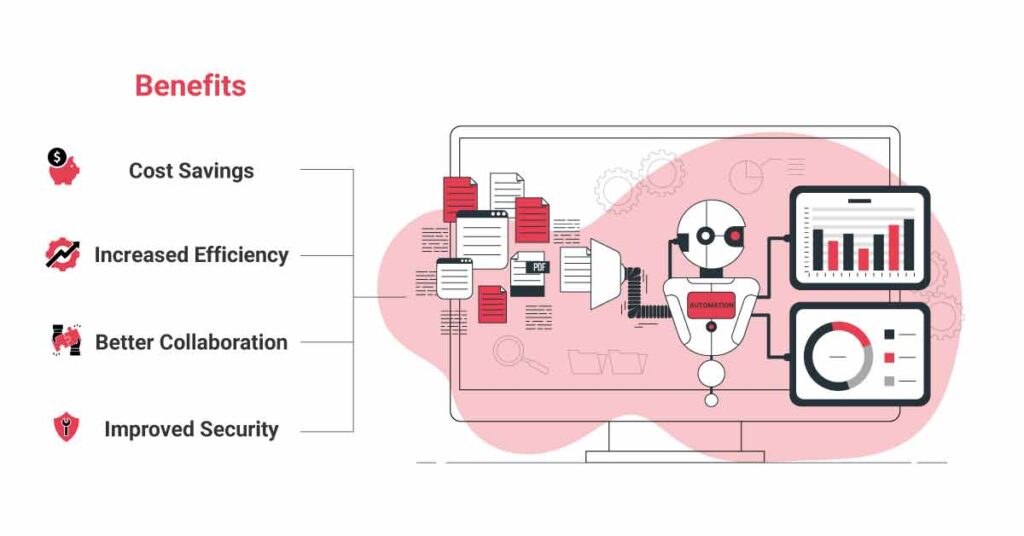It is critical for companies to optimize their business processes in order to remain competitive. Digitalization is acquiring new peaks everyday and when business fails to upgrade, they can easily be out of the competition any day! Enterprise workflow automation is the solution here!
Table of Contents
ToggleBefore everything else, first of all let’s understand the problems and challenges faced by the enterprises.
Challenges Addressed
In the journey towards effective enterprise workflow automation, addressing and overcoming daily business challenges is fundamental. This section succinctly outlines the key points:
Identifying Business Hurdles:
The initial stride involves a keen recognition of the hurdles hindering daily operations. This encompasses a spectrum of challenges ranging from manual tasks to communication bottlenecks.
Cumbersome Manual Tasks:
Workflow automation takes aim at streamlining and automating manual tasks that consume time and resources. It alleviates the burden of repetitive, time-intensive processes.
Communication Bottlenecks:
Recognizing the significance of smooth communication, workflow automation strategically tackles bottlenecks. It ensures a seamless flow of information within the organization, minimizing delays and enhancing collaboration.
Strategic Problem-Solving Ally:
Workflow automation goes beyond merely addressing challenges; it becomes a strategic ally in problem-solving. By strategically implementing automation, businesses not only resolve existing issues but also preemptively mitigate potential future challenges.
Holistic Approach:
It emphasizes that workflow automation doesn’t offer piecemeal solutions but adopts a holistic approach to identify, understand, and strategically navigate the spectrum of challenges businesses encounter in their day-to-day operations.
Let’s look at the features of Enterprise workflow automation and how it can be helpful to you and your organization for process automations!
Benefits of Enterprise Workflow Automation
In a Gartner poll, more than 85% of CIOs stated they were active in their organization’s sustainability activities.
Enterprise workflow automation provides numerous advantages when it comes to increasing productivity, reducing costs, and improving customer service.
At its most basic level, enterprise workflow automation involves leveraging technology to enable employees and systems to
- communicate,
- streamline processes,
- coordinate tasks, and
- manage data.
By automating workflows, businesses can reduce the time required for manual processes while also providing more accurate results. This process enables organizations to achieve greater efficiency and better customer service.

Cost Savings
Investing in enterprise workflow automation can save businesses money by reducing manual labor associated with traditional processes. Automated workflows are designed to complete tasks automatically, without human intervention.
This reduces costs associated with staff training, employee wages, and overhead expenses such as office space or other material costs.
Automation also eliminates the need for extra equipment or software applications which further helps businesses save money in the long run.
Increased Efficiency
Enterprise workflow automation not only saves time but also increases efficiency by eliminating redundant steps in a process or assigning tasks to the appropriate people at the right time.
Automated workflows are designed to complete tasks faster than manual processes which results in improved customer satisfaction due to faster response times.
Better Collaboration
It provides better collaboration between employees and departments by creating a unified system of communication that is easily accessible from anywhere.
This enhances collaboration between teams by allowing them to access important documents quickly and easily, enabling them to take timely decisions regarding projects without inhibiting progress or leaving out crucial details from conversations.
Improved Security
Helps improve overall security by providing tighter control over access rights and privileges assigned to users of an organization’s system.
By setting limits on who has access to certain parts of the system as well as monitoring activity within it, organizations can ensure that confidential information remains secure and only accessed by authorized personnel within the organization.
Implementation strategies
Effective implementation of workflow automation is a delicate process, and this section underscores key strategies through concise pointers:
Assessing Your Workflow Needs
Crucial Evaluation:
The initial step involves a critical evaluation of existing workflows. This is imperative to gain a profound understanding of the current state of operations.
Determining Automation Requirements:
The assessment serves as a compass to pinpoint specific areas that would benefit most from automation. It shapes the roadmap for automation by identifying needs and pain points within the workflow.
Read More: Explore the scope of usage of Workflow Automation in different industries and everyday scenarios!
Choosing the Right Automation Tools:

Alignment with Business Goals:
The selection of automation tools is a strategic decision that demands alignment with overarching business goals. This ensures that the chosen tools seamlessly integrate into the existing infrastructure, facilitating a smooth transition.
Seamless Transition:
By aligning tools with business objectives, the implementation becomes a cohesive process. The selected tools not only address immediate needs but also contribute to the long-term vision of the organization.
Ensuring Scalability:
Beyond an Option:
Scalability is positioned not merely as an option but as an indispensable necessity for future business growth. It emphasizes the importance of choosing automation solutions that can seamlessly adapt and expand alongside the evolving needs of the business.
Future-Proofing:
This strategy serves as a form of future-proofing, acknowledging that the chosen automation framework should not only meet current requirements but also have the elasticity to accommodate the business’s growth trajectory.
Choosing the Right Technology
Navigating the technological landscape for optimal workflow automation involves critical decisions. This section succinctly captures key considerations:
Evaluating AI and Machine Learning Integration:
Advanced Technological Integration:
The section delves into the strategic integration of advanced technologies such as Artificial Intelligence (AI) and Machine Learning (ML) into workflow automation.
Enhanced Capabilities:
By evaluating AI and ML integration, businesses unlock capabilities that go beyond traditional automation. Smart algorithms and data-driven insights become integral components of the automated workflow, enhancing decision-making processes.
Exploring No-Code and Low-Code Platforms:
Understanding Platform Diversity:
The exploration extends to understanding the dynamics of No-Code and Low-Code platforms, offering insights into their benefits and considerations.
Empowering Non-Technical Users:
No-Code platforms empower users with no coding expertise to actively participate in the automation process. Proving as a gem of the present it is helping almost all the industries and no-tech people to easily build applications, web pages, etc., to be precise!
Strategic Decision-Making:
Aligning with Business Objectives: The overarching theme is aligning technology choices with specific business objectives. Whether opting for AI and ML for advanced capabilities or No-Code/Low-Code platforms for accessibility, the decision-making process is strategic.
Balancing Complexity and Accessibility:
Complexity vs. Accessibility: The discussion touches upon finding the right balance between the complexity of technology and its accessibility. This ensures that the chosen technology not only meets the technical requirements but is also user-friendly for seamless adoption.
Companies and enterprises should be well informed in selecting the appropriate technology for workflow automation that takes balancing innovation with practicality into account for successful implementations.
Conclusion
Now-a-days, businesses should focus on adapting enterprise workflow automation tools as early as possible. They can make use of No-Code platforms and build custom solutions to their problems anytime and anywhere! Seems no point to be left out of competition. You have everything in your hands!
If you are left with any sort of doubt, feel free to connect and discuss! You can come down to the comment section as well!
Frequently Asked Questions
1. What is Enterprise Workflow Automation?
Enterprise Workflow Automation is the use of technology to streamline and automate business processes. It eliminates manual tasks, reduces errors, and improves efficiency by integrating different systems and tools to create seamless workflows.
2. Why is Workflow Automation Important for Businesses?
Workflow automation enhances productivity by reducing manual work and minimizing errors. It improves collaboration across teams, ensures process consistency, and speeds up decision-making. By automating repetitive tasks, businesses can focus on strategic goals, leading to better customer satisfaction and cost savings.
3. What Types of Business Processes Can Be Automated?
Many business processes can be automated, including employee onboarding, invoice processing, customer support workflows, marketing campaign management, approval processes, and data entry. Any task that follows a set pattern and requires repetitive actions can benefit from automation.
4. How Does Workflow Automation Improve Efficiency?
Automation reduces human intervention, ensuring tasks are completed faster and with fewer errors. It allows different software applications to communicate seamlessly, eliminating data silos. By maintaining consistency and accuracy, workflow automation optimizes productivity across departments.
5. What Are the Key Features of a Good Workflow Automation Tool?
A well-designed workflow automation tool offers an intuitive drag-and-drop interface, integration with third-party applications, role-based access control, real-time analytics, and AI-driven automation. No-code or low-code options make it easier to implement without extensive technical expertise.
6. Is Enterprise Workflow Automation Secure?
Yes, most enterprise workflow automation solutions prioritize security through data encryption, role-based access control, audit logs, and compliance tracking. Secure API integrations ensure that data flows safely between systems, reducing the risk of unauthorized access.
7. How Can Small Businesses Benefit from Workflow Automation?
Small businesses can use workflow automation to reduce operational costs, improve efficiency, and streamline processes with limited resources. Automation enables better customer service, faster approvals, and a more organized workflow, helping small businesses scale efficiently.
8. How Long Does It Take to Implement Workflow Automation?
The implementation time varies based on the complexity of workflows. Simple automations can be set up within hours or days, while enterprise-wide automation projects may take weeks or months. No-code and low-code platforms significantly reduce the time required for deployment.
9. Can Workflow Automation Integrate with Existing Business Software?
Most modern workflow automation tools offer seamless integration with existing business applications, including CRM, ERP, HRMS, cloud storage, and communication tools. This allows organizations to connect their workflows without disrupting their current systems.
10. How Do I Choose the Right Workflow Automation Solution?
Selecting the right workflow automation solution depends on factors such as ease of use, integration capabilities, scalability, security features, and cost-effectiveness. Evaluating multiple options and running a pilot test can help determine the best fit for a business’s specific needs.
